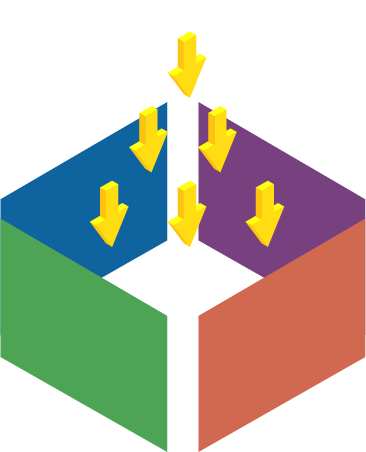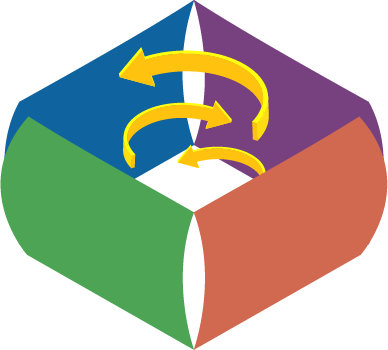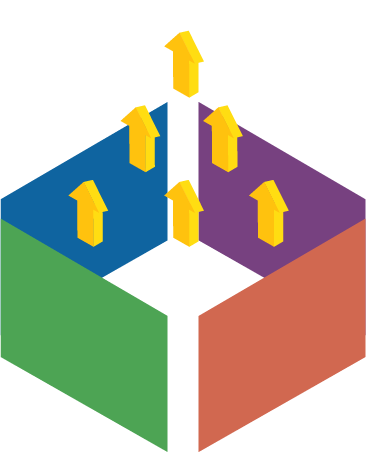
Internal Research We prepare a strategic base for all the creative work that follows by conducting our own research with the client’s management team.
External Research We use the findings of qualitative research as the basis for developing a differentiation strategy that isolates points of difference between the brand and its competitors. We identify personality traits that fit the strategy, the client’s philosophy, and the expectations of its customers.
Empathetic Research We conduct in-depth interviews with carefully selected participants, followed by structured debriefing sessions. This allows us to gain an empathetic understanding of users’ behaviors, insights and consumer paths, and to spark new ideas that can be developed for the Brand Differentiation Strategy.
Brand Differentiation Strategy We determine the audience segment, the business category, the differentiating characteristics of the brand, the customer challenges that will help establish empathetic bonds with them, the brand challenges the client is facing, and suggestions on how to turn them into opportunities.
Archetype and Persona We explore a brand archetype and a set of brand personality traits for the brand, which will define and energize each other, and can be used as emotional criteria for development of the Core Brand Identity and its media applications.
Brand Relationship Structure We explore the benefits and liabilities of varying degrees of marketing communication linkages between the client’s parent brand and its sub-brands. We then recommend a strategic relationship structure that achieves maximum benefit for both the parent brand and sub-brands.
Brand Name We create a selection of brand name recommendations. We may conduct surveys of brand name candidates to test phonetic pronunciation qualities and intended associations. We conduct preliminary brand name trademark searches via IP specialists, and assist with officially registering the chosen name.
Brand Positioning Phrase We explore and recommend positioning phrases in Vietnamese and/or English that help support the Brand Differentiation Strategy favorably in the mind of its market audience.
Core Brand Identity We explore logotypes and other brand identity elements. We may conduct surveys to test readability and associations. We conduct preliminary trademark searches, and help register the chosen logotype. We prepare digital master art versions of the logotype for print production requirements.
Master Brand Format We explore design formats that fit all media needs and express the Brand Persona, creating a distinctive and consistent appearance for the client in the marketplace.
Brand Atmospherics We propose suggestions and directions for the sensory elements inside a transactional space, such as graphics, sound and smells. This is to create the criteria for interior design firms and fabricators so they can create brand-compatible interior designs.
Integral Persona Ideation We conduct a half-day workshop for the client’s departmental executives to introduce and use an ideation method that will enable them to discover ways the Brand Persona can be applied to their department’s day-to-day activities, to evaluate the best ideas, and to make them actionable.
Ideation Practices We prepare and conduct a half-day workshop for the client’s executive personnel to give them direct experience in ideation methods that will improve the quantity and quality of their ideas, and enable them to lead others on their teams to do the same.
Static Media Systems We apply the approved Core Brand Identity and Master Brand Format to create demonstrations for media formats that rarely change over time, such as stationery, business cards and signage.
Dynamic Media Systems We apply the approved Core Brand Identity and Master Brand Format to create demonstrations for media formats that often require more extensive format changes depending upon their content and competitive marketing conditions, such as billboards, digital ads and company literature.
Brand Guidelines We create these fundamental documents to describe the brand personality, name, logotype and other Core Brand Identity elements, a miscellaneous media guideline, and a detailed media guideline that specifies how to apply the Core Brand Identity elements to the relevant media types.
Brand Image Perpetuation A company’s brand image is an intangible asset that should grow in strength and value over time. We offer a service that assures our clients of the effective implementation of their brand identity system, and the maintenance of it over the years that follow.
Core Brand Identity We explore logotypes and other brand identity elements. We may conduct surveys to test readability and associations. We conduct preliminary trademark searches, and help register the chosen logotype. We prepare digital master art versions of the logotype for print production requirements.
Desktop Research We prepare a questionnaire that covers the brand’s business, marketing and communication strategy issues within one year. We arrange face-to-face meetings in order to gather this information, and then we send the completed questionnaire to the client to confirm the information.
Customer/Consumer Interviews We conduct this research to gather information about the industry, the market, external factors affecting brand communication and the brand’s competitors, as well as to gain insights into the audience. We also use the empathetic research conducted within the Strategic Brand Identity service.
Customer Journey Research We conduct research to determine the exact steps that a consumer takes along the path to becoming a user of a product or service.
Creative Brief Preparation We prepare the creative brief to the client, which ensures that the most condensed information about the project, the creative requirements, are fully conveyed to the creative department when implementing items based on the brand strategy.
'Big Idea’ Group Ideation We come up with a method for communicating the message that effectively builds the brand’s image and solves the marketing problem at the same time. The Big Idea is a beacon that guides the campaign, and communicates one single-minded message.
Selection We use ideation methods to explore ideas. We then proceed with the selection stage in which we narrow the ideas down to those that address the problem statement.
POINT We analyze the Plusses, Opportunities, Issues and New Thinking to strengthen or evaluate an idea. We avoid underdevelopment of an idea, think of ways to overcome an idea’s weaknesses, work on single ideas, and create motivation by looking at opportunities to overcome challenges.
Campaign Roadmap We arrange key activities at different touchpoints to reach the target audience and tell a consistent story across all channels. This is the big picture to see how branding communications would be executed, and is a guide for the execution team to work on.
Key Visuals, Storyboards and Mockups We produce key frames for the storyboard, and ensure that the brand and marcom message is delivered. We also produce mockups for other key materials, including key visuals, print ads, social media posts and OOH materials.
Preliminary Orientation Before QuikTrek starts, we meet with the client’s team to decide on the focus and preliminary Problem Statement for the project. We initiate participant selection, conduct preparatory research, arrange the Ideation Room and set up the QuikTrek team’s online file-sharing system.
Participant Selection We decide on participant criteria using a method that ensures that our research respondents represent the product’s segmentation.
Empathetic Research Interviews Members of the QuikTrek team meet with the respondents individually to learn about their lives, their feelings about the product segment we are probing, and their purchasing habits. We then produce transcripts of the interviews.
Observation & Insight Sharing QuikTrek team members share what they’ve learned from each interview, and present all the facts, insights and preliminary ideas gleaned. Team members describe their experience of their interviews to the others, so that the team as a whole gains an empathetic understanding of each of the participants.
Mapping & Plotting We complete a multi-aspected description of each participant in terms of their persona, empathetic qualities and purchasing decision path.
Problem Reframing We reexamine and restate the Problem Statement, shaped by our greater understanding of all that may relate to the discovery of a differentiated product or service idea that will truly serve the needs of customers and strengthen the unique positioning of the brand.
Clustering We reorganize all individual facts, insights and ideas into categories that are revealed in the process.
Category Clustering and Diagramming From the cluster categories we look for overriding concepts and attempt to clarify them in a diagrammatic manner.
Customer Characterizing We cluster the individual studies of participant persona, empathy and decision paths to determine if any can be consolidated into descriptions that will help us understand the brand’s customers more deeply.
Ideation and Shortlisting Using ideation methods appropriate for whatever content is revealed, we look for differentiating relationships within and between clusters, noting beneficial ideas, and then vote for a shortlist of the best ideas.
POINT Exercise We evaluate each of the shortlisted ideas in terms of their Positives, Opportunities and Issues, then reenter a New Thinking mode to improve each idea and vote to select the four best ideas.
Lo-Res Prototyping Using a 3D method of 'thinking with our hands', we further explore the four best product ideas using simple tools and materials. For service ideas, we use a form of storytelling.
Lo-Res Proof of Concept After evolving each of the four idea prototypes, we test market feasibility by first developing a list of features and benefits, and then developing a marketing communication concept demonstrated in rough form.
Hi-Res Prototyping After selecting the best of the four product ideas, we devise a way of portraying it realistically to a user. With reference to the customer journey research and analysis, we refine the marketing communication concept, and make a preliminary media plan for it.
Live Test We introduce the hi-res prototype to the original research participants to reveal their assessment of the product or service. The team then analyzes the video of the presentation to prepare a list of refinements that can be made by the client as they develop the product or service for market use.
Final Presentation We present a summary of the entire QuikTrek process and the final product to the client, along with the marcom recommendation and any recommendations for further refinement in the client’s development process. We finalize the shared file system so that the client’s team can refer to it when developing future products or services on their own.
Executive Interviews We will interview company executives to learn of current activities that benefit the environment, society at large and employees through governance policies. For a standalone ESG service we will also ascertain the brand’s current brand image strategy.
Customer Interviews We will conduct in-depth interviews with typical customers in the brand’s segment to learn what sort of ESG practices in that particular segment might resonate with them.
Competitor Research We will study the PR and marketing communications of the company’s major competitors to learn what specific ESG practices they may be known for.
ESG Current Practice Evaluation We will evaluate the company’s current ESG practices to learn which practices, if any, are of benefit relative to their brand image strategy, and where there may be gaps to explore
ESG Customer Expectation Evaluation We will evaluate what sort of ESG practices typical customers in the company’s segment expect, to learn which of them might also relate to the company’s brand image strategy
ESG Brand Fit Opportunities We will evaluate the ESG practices of competitors to determine if there are any areas of opportunity designated for exploration by the company.
Collaborative Ideation We will conduct a half-day ideation session with department managers to explore ESG ideas that fit the areas of opportunity determined in the Analyze Stage. We then conduct an exercise to determine best practices, and refine them to overcome any weaknesses and maximize their effectivenes
'Big Idea' Ideation We will create a way of communicating the company’s ESG activities in a way that appeals to their target audience, that supports the company’s particular brand image, and that differentiates them from competitors, thereby maximizing marketing communication budgets.
POINT We will analyze leading ideas using the POINT process of Plusses, Opportunities, Issues and New Thinking to overcome any weaknesses and maximize communication effectiveness.
Campaign Roadmap We will arrange key communication activities at different touchpoints to reach the target audience and tell a consistent story across all channels.
Key Visuals, Storyboards and Mockups We will produce key frames for storyboards and ensure that the key main ESG message is delivered. We will also produce mockups of key visuals applied to visuals elements such as print ads, social media posts and OOH materials.
Stage in which research occurs Stages that benefit from this research



Creating ideas is often called 'thinking outside the box'. But the most practical ideas often occur just by getting to know what’s in the box better. Some ideation methods we use are:
More imaginative solutions require broadening our focus to develop ideas that occur at the outskirts of our problem perimeters. Some ideation methods we use are:
Creating highly differentiated solutions requires thinking less precisely about the problem to spark wilder ideas, and then ideating how they can be adapted to fit it. Some ideation methods we use are: